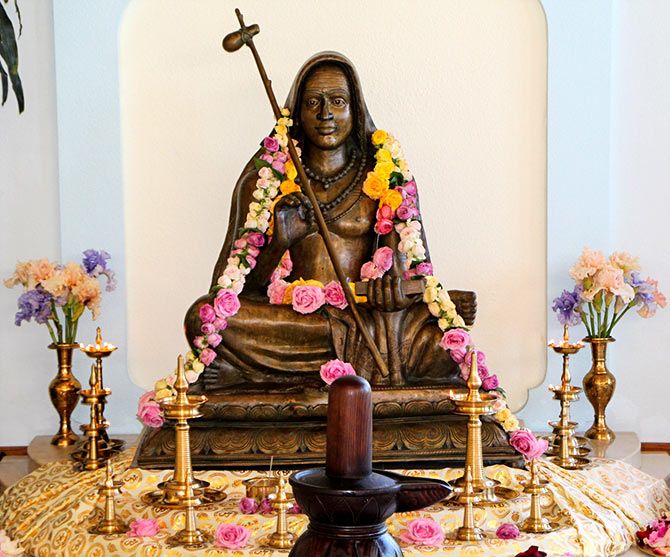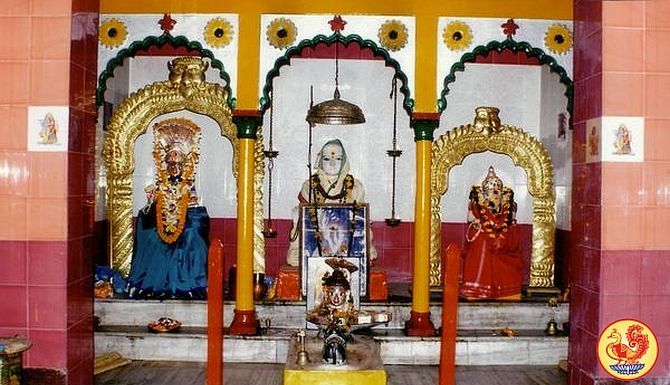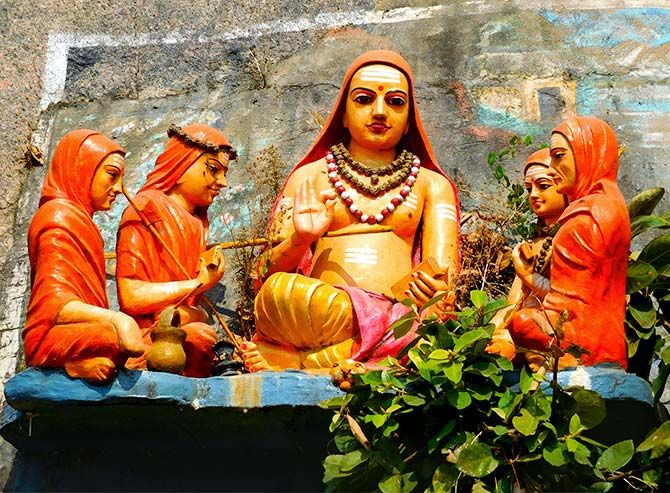 | « Back to article | Print this article |
Pavan K Varma, diplomat, writer and politician, embarks on a quest about Hinduism's great thinker's stay in Varanasi.

I visited Varanasi to try and find more about Shankara's sojourn there.
My first stop in Varanasi is the Sampoornanand Sanskrit University.
Professor Hari Prasad Adhikari, who heads the faculty of philosophy and teaches comparative religion, has arranged for me to meet with scholars on Shankara and Hindu philosophy.
There are no tables and chairs. We sit on a white sheet on the floor with bolsters for a backrest.
The session kicks off with a mangalacharya, an invocatory recital of some stotras or devotional hymns, written by Shankara.
What follows looks uncannily like a replay of how a shastrartha must have happened in the days of Shankara.
Several professors of different aspects of Hindu philosophy are present. Each of them is a passionate believer in his viewpoint and interpretation.
All of them accept the primacy of the Advaita doctrine developed by Shankara, but all of them have a different take on it, and evaluate it from the point of view of their own philosophical 'loyalties'.
A robust disputation follows, with Sanskrit shlokas being thrown about with abandon, as each speaker stresses a different point of view on such esoteric matters as the difference between shabda or word knowledge, pratyaksha jnana or direct intuition, the validity of shruti or the revealed word, the influence of Buddhist thought on Shankara's thinking, the limitations of Advaitic monism, and the validity of Vishista Advaita or qualified non-dualism as developed by later Hindu philosophers like Ramanuja.
Tempers rise and opinions clash.
When someone interrupts a speaker, he protests vehemently that this is contrary to the rules of shastrartha, where each protagonist must be allowed to present his point of view fully before objections are raised.
Professor Adhikari tries valiantly to moderate the discussion but is often disregarded.
This goes on for more than an hour, until Adhikari brings the meeting to a close by the ceremony of upa-samhara, which is in the nature of a summation and vote of thanks.
By this time tempers have cooled down, and I am informed that such displays of embattled ideological confrontations on obscure points of Hindu metaphysics is not uncommon among a small group of Philosophy teachers who have spent a lifetime studying the Sanskrit texts.
In fact in a shastrartha some years ago, one professor, who was very highly regarded for his erudition, was so incensed by his adversary's interpretation of Shankara's tenets, that he died of a heart attack while making his rebuttal.
There was something of the surreal in what I had witnessed.
Here, in this non-descript room of a university that is visibly in physical neglect, were a handful of people arguing as if their life depended on it, on matters about which the overwhelming bulk of Hindus have no clue!
Was there, in what I had just seen, a resurrection of what must have happened on the banks of the Ganga in the time of Shankara?
Perhaps yes, but the difference being that then even ordinary people wouldn't have been completely unaware of the subjects being discussed, and actually lived the Hindu philosophical experience of ideas and arguments.

The Sampoornanand Sanskrit University is among India's oldest educational institutions.
It was set up in 1791, ironically by an Englishman, Jonathan Duncan, who persuaded Governor General Lord Cornwallis on the need for a Sanskrit college to translate important texts, including those needed for administrative needs.
An annual budget of Rs 20,000 was sanctioned, and John Muir was appointed the first principal of the college.
In 1857, the college began post-graduate teaching, and in 1974 was conferred the status of a university.
But the university languishes now, for most Indians have little time for Sanskrit, or the vast wisdoms contained in its texts.
In many ways, thus, the vehemently argumentative professors quoting Sanskrit shlokas to discuss the intricacies of Hindu philosophy have become relics in their own land.
The Saraswati Library of the college, set up as far back as 1894, has one of the most valuable collections of Sanskrit manuscripts, but most of them remain unstudied.
The motto of the university is Srutam Me Gopaya: Let my Learning be Safe. Unfortunately, it seems that the British -- for their own reasons --were more concerned about this, than we are today.
None of the professors were able to tell me historical details about Shankara's stay in Varanasi.
Their plea was that in those times, scholars were more concerned about ideas and concepts than about chronology and sites, and so, no details have been left for posterity.
What was Banaras like when Shankara lived here?
Where did he live? And for how long did he stay?
Nobody seemed to know.

I visited Kedara Ghat where a branch of the Sringeri Matha was established possibly as far back as the fourteenth century CE. This is what I infer from a plaque inside the Shri Jagadguru Shankaracharya Mutt that reads: 'This ancient Chandramoulishwara Lingam was installed and worshipped by His Holiness Sri Vidyaranya Mahaswamiji Sri Sringeri Sharada Peethadipathi in the year 1346 AD.'
Inside the matha is a temple with shrines of Ganesha and Devi Sharada, with the statue of Adi Shankaracharya, similar to the one at Kaladi, placed between them.
Did the Sringeri Matha choose this site because Shankara lived here, or in the vicinity?
The area where it is located has a preponderant presence of residents from south India.
How old is this regional linkage, and could travellers from the south have come here to stay even a thousand years ago?
If so, there is the possibility that Shankara, hailing from Kerala, would have chosen to live here. But again, no one had answers.
Whatever the exact location of Shankara's abode in Kashi, there are some incidents of his life there that have been recorded by biographers.
There are several biographies called Shankara Digvijaya, but the most popular is that written by Madhavacharya, who later took on the name of Sri Vidyaranya and became the 12th head of the Sringeri Sharada Peetham (1380-1386).
In these traditional accounts, there is a great deal of hyperbole regarding miracles performed by Shankara.
If these are discounted as the excesses of biographers, we can still cull out some events that are common to all accounts and must, therefore, have some basis in fact.
There is agreement that when in Kashi, Shankara acquired one of his most dedicated devotees, Sanandana.
Legend has it that one day, when Sanandana was on the other side of the river, Shankara asked him to return by walking across.
Without a thought the pupil, in absolute faith, obeyed the commandment. As he did so, the Ganga put forth a lotus to support him, and so Sanandana actually walked across the river.
After this, Shankara renamed him Padmapada (lotus-footed).
But legends apart, there are three incidents at Varanasi that are important for providing an insight into Shankara's thinking, and the texture of his times.

The first relates to his meeting with a chandala or 'outcaste', someone traditionally regarded to be from the lowest rungs of society. The encounter took place in the narrow alleyways of the embankment.
Apparently, Shankara was going to the Ganga to bathe when he came upon the chandala.
In those days, Brahmins were supposed to be 'defiled' by the very presence of those of this caste, and the disciples of Shankara asked the 'outcaste' to move out of the way.
However, the chandala retorted by asking the question: 'How do differences such as "This is a chandala and this is a Brahmin" arise in the Advaitic doctrine? After all, it is the same Atman that is present in all bodies, irrespective of their castes?'
Shankara was taken aback by this response, and promptly exclaimed that anyone who sees Brahman as the sole reality and recognises the Atman as the same in all is worthy of respect.
All other distinctions are false, said Shankara, and the chandala, who has realised the unity of the supreme consciousness, is akin to my guru.
It is this thought that is enshrined in Shankara's five-stanza composition, the Manishapanchakam, of which a representative stanza reads as follows:
I am Brahma alone. And, this entire world has been spread out by pure consciousness. All this, without residue, has been superimposed by me through nescience which consists of the three gunas (sattva, rajas and tamas). Thus, he in whom there is firm knowledge in respect of the eternal, blemishless supreme (Brahma) which is unexcellable bliss, is the preceptor, be he a chandala or a brahamana. This is my conclusive view.
What needs to be mentioned here is that some biographers have tried to reassert the validity of the rigid and discriminatory social system by underplaying the wisdom of the chandala.
According to their versions, the moment Shankara uttered his thoughts -- revolutionary for their explicit denial of social orthodoxy -- the chandala disappeared and in his place Shiva and the four Vedas appeared.
The attempt here is to marginalise the remarkable assertion for equality of the chandala, and give to the whole incident a sacred gloss, in the form of Shiva and the Vedas.
The scholars at the Sanskrit university whom I met did much the same when they told me that the chandala episode was but a way to demonstrate that even the lowest of the low in Kashi were imbued with philosophical insight.
The truth, however, appears to be that for Shankara, consistent with his own philosophical logic, there was, in his meeting with the chandala, the express rejection of social exclusion created by man-made institutions.
The second incident is about Shankara's reaction to a student enthusiastically engaged in learning Sanskrit grammar.
Hearing him trying to memorise the rules of grammar by rote loudly, Shankara is supposed to have spontaneously composed one of his most popular hymns, Bhaja Govindam, in which the last line of every stanza exclaims: Worship Govinda, worship Govinda, worship Govinda, foolish one! Rules of grammar profit nothing once the hour of death draws nigh!
As an example of devotional or bhakti hymns, Bhaja Govindam must rank very high, and is even today sung all over India.
It indicates Shankara's impatience with mechanical learning, and his emphasis on the need to use the path of knowledge -- the jnana marga -- for acquiring the wisdom than enables the achievement of moksha through a true understanding of the transience of the empirical world, to which we give so much undue importance.
The third incident is about a disputation he had with an old man on the interpretation of the Brahma Sutra.
The argumentation went on for almost a week, with neither protagonist willing to yield ground and, if what I had witnessed in the brief shastrartha at the Sanskrit university was illustrative, it must have involved some degree of frayed tempers, sarcasm and acrimony.
Finally, so the story goes, Padmapada, Shankara’s disciple, appealed to Vishnu to bring the argument to an end.
It was ultimately revealed, so traditional biographies claim, that the old man was an incarnation of Vyasa, the author of the Brahma Sutra.
This episode, more realistically, is probably indicative of the fact that there was a good deal of wrangling over Shankara's commentary on the Vedanta Sutra, and that he was perhaps occasionally forced to give up his earlier positions and meet opponents half-way.
The old man here may well represent an opponent of that kind, whom Shankara could not find it quite easy to satisfy and whose acquaintance with the literature of the Vedanta philosophy must have been so good as to entitle him to be looked upon as a reincarnated Vyasa.
After spending several years in Kashi, with occasional trips to Badrinath, Shankara went to Prayaga (modern Allahabad).
It is said that Ratan Singh, the then ruler of Banaras, persuaded him to stay on, but Shankara explained that his mission lay in being a peripatetic teacher and to spread his philosophical vision to all parts of Bharat.
Excerpted from Adi Shankaracharya: Hinduism's Greatest Thinker by Pavan K Varma, with the kind permission of the publishers, Tranquebar Westland.
